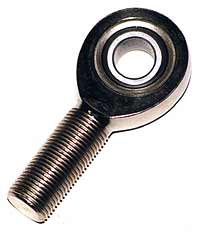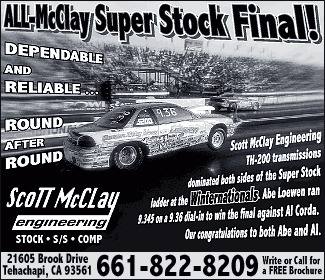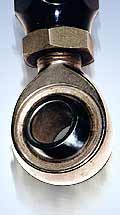
Part 1
6/7/04
Inside today’s drag cars, you’ll find all sorts of rod ends or spherical bearings. Rod ends, or as the Brits sometimes call them, “rose joints,” happen to be one group of components that get little or no respect. They all look the same (sort of), and when they’re buried deep inside of a car, they’re out of sight and out of mind. However, rod ends may be one of the most critical hardware pieces on your drag car. And yes, they see use in places other than the suspension. For example, rod ends are used in the carburetor linkage. Because they’re not a high profile component, they’re very easy to forget about. Until they break.
When a rod end breaks, things can get ugly. Fast. You see, most rod ends are regularly used in places where they’re charged with handling considerable loads. Rod ends are more than important. They’re critical. And there’s something even more acute: Not all rod ends have been created equal. Some are true aerospace quality. Others are nothing more than junk. Where it becomes really confusing is when you look at a rod end. It’s difficult to tell the difference between an extreme quality rod end and one that just fell off the boat from some sweat shop in the Eastern hemisphere.
 When
shopping for rod ends for a racecar, look for models like this. They’re
a three-piece precision design. In rod ends with this construction format, the
race is formed around the ball and then the race insert is staked into the body.
This type of construction offers a much closer fit along with a much higher
degree of precision between the ball and the race. Because of the three-piece
design, different materials can be embodied during construction. This process
allows the rod end to best match the application (i.e.: strength versus loads).
When
shopping for rod ends for a racecar, look for models like this. They’re
a three-piece precision design. In rod ends with this construction format, the
race is formed around the ball and then the race insert is staked into the body.
This type of construction offers a much closer fit along with a much higher
degree of precision between the ball and the race. Because of the three-piece
design, different materials can be embodied during construction. This process
allows the rod end to best match the application (i.e.: strength versus loads).
The Rudiments Of Rod Ends
By design, a rod end basically consists of a spherical ball that is designed to rotate inside a housing. This ball is the bearing and the housing it’s contained in is the race. The spherical ball is machined flat on each side, and this modified “sphere” is bored with a hole through the center.

There’s something you really can’t see here. Rod ends are usually available with left or right hand threads. That means that for an application such as a trailing link, you simply order the appropriate bearing (be careful—some of the part numbers listed in rod end catalogs are at the best, confusing when it comes to thread types). There’s another thing to consider: Be careful when purchasing jam nuts. They’re not all created equal either. Quite frankly, the A-N or aircraft hardware industry is plagued with inferior knock-off components. And like inferior rod ends, some of this stuff is absolute junk.
That’s the rudiments, but there’s more. When shopping for rod ends for your race car, you’ll often come across “commercial” or economy models. Although there are a number of different economy rod ends available (that’s where most of the Far East imports come into play), the only type you should even think about for a serious application are the fully swaged, two-piece models. On these rod ends, the body is formed (or “swaged”) around the ball so that the race the ball rides on is actually part of the body. When looking at inexpensive rod ends, this is the only type that offers decent radial or pull strength coupled with good axial strength (axial strength is the resistance of the ball being pushed out of the side of the body).
Real rod ends use a three-piece precision design. In this application, the race is formed around the ball and then the race insert is staked into the body. Why is this important? Simple. This type of construction offers a much closer fit along with a much higher degree of precision between the ball and the race. Quite often, this three-piece configuration is called an “aircraft” rod end. The three-piece design allows different materials to be incorporated during the construction process. In turn, this allows the rod end to best match the application. Races can be made of mild, alloy or stainless steel (brass or aluminum bronze is sometimes used, but should be avoided because of its low strength) and bodies are made in mild, alloy, stainless steel, aluminum or even titanium.
Teflon Lubrication …
Another common option on rod ends is a Teflon liner. This allows the rod end to be self-lubricating. This is important, since it’s usually difficult (if not impossible) to grease or oil a rod end once it’s installed on a car. But more important is the fact that grease fittings can physically weaken the rod end (a good comparison is a common universal joint with a
|
ADVERTISEMENT  |
A Teflon liner eliminates most, if not all of these circumstances. By design, a Teflon liner consists of a carrier component, usually a fabric (which provides compressive strength) and a Teflon component for lubricity along with various bonding resins. The Teflon liner is bonded to the race so that the ball actually rides on the liner. The movement of the ball rubs Teflon on the ball which, in turn, provides lubrication. Typically you can purchase two or three-piece rod ends with Teflon liners. When looking at Teflon-lined rod ends beware of inexpensive examples with virgin Teflon. It’s relatively soft (approximately 10,000 pounds PSI compressive strength). Meanwhile, a high quality composite Teflon liner will have a compressive strength of somewhere between 40,000 and 60,000 PSI. You’ll also find that a good Teflon liner eliminates clearance between the ball and race, which in turn, makes for a tighter fit.
 This
Aurora rod end has a composite Teflon liner (usually, you can purchase two or
three piece rod ends with Teflon liners). By design, the liner consists of a
carrier component, usually a fabric (which provides compressive strength), a
Teflon component for lubricity along with various bonding resins. The Teflon
liner is bonded to the race so that the ball actually rides on the liner. The
movement of the ball rubs Teflon on the ball which provides the lubrication.
This
Aurora rod end has a composite Teflon liner (usually, you can purchase two or
three piece rod ends with Teflon liners). By design, the liner consists of a
carrier component, usually a fabric (which provides compressive strength), a
Teflon component for lubricity along with various bonding resins. The Teflon
liner is bonded to the race so that the ball actually rides on the liner. The
movement of the ball rubs Teflon on the ball which provides the lubrication.
Of course, simply adding a Teflon liner to a rod end doesn’t insure precision or performance. One term you’ll come across when dealing with rod ends is “beating out”. What this refers to are usually a couple of distinct problems. The first is the deformation of low strength “self lubricating” liners. You see, some “econo rod ends” have races that are constructed with molded plastic (occasionally mixed with a fiberglass filler). Teflon may also be added for lubricity. These units have a compressive strength of no more than 15,000 PSI. This causes the race to deform long before the body sees any damage.
The other type of liner “beating out” failure involves the physical bond between the liner and the race. The self-lubricating nature of the liner sometimes makes it difficult to bond to the race. If the manufacturer can’t make this bond sufficiently strong, then the liner will become detached from the race. Each time there is a misalignment of the rod end (more on this later), pieces of the liner will disintegrate. The end result will be a rod end with clearances that prove excessive. Aside from government MIL Specs for Teflon-lined bearings, there are no standards set for liner bond strength. Of course, if a rod end manufacturer can meet this standard and manufactures a line of bearings approved for military use, then there’s a good chance that their high quality Teflon-lined race bearings also use this same manufacturing criteria.
Aligned Or Misaligned?
What is rod end “misalignment” all about? Remember when we pointed out the basics of rod end design (the sphere inside the race)? Basically, it’s no secret that a bolt or fastener of some sort goes through the hole bored through the center of the rod end. Because of this, it’s obvious that it cannot rotate inside the housing a full 360 degrees (without the fastener through the center, the ball can rotate through a full circle). Given this fact, all rod ends have limitations in regard to how far they can be misaligned before the sphere binds in the housing. The angle of misalignment is a crucial factor when selecting rod ends. Not all rod ends can accept the same degree of misalignment as others. If you exceed the manufacturer’s recommended maximum angles, the smallest thing you’ll find is premature rod end wear. On the other end of the spectrum, the worst thing you’ll find is outright rod end failure.
 Take
a close look at this rod end. See how the “ball” isn’t centered?
This is the “misalignment” that the rod end design can handle. Check
the manufacturer’s recommended maximum angles in their respective catalog,
then order the right bearings (different rod ends have different misalignment
tolerances). The text offers info on measuring misalignment (it’s simple
stuff).
Take
a close look at this rod end. See how the “ball” isn’t centered?
This is the “misalignment” that the rod end design can handle. Check
the manufacturer’s recommended maximum angles in their respective catalog,
then order the right bearings (different rod ends have different misalignment
tolerances). The text offers info on measuring misalignment (it’s simple
stuff).
So how do you know how much the angle of misalignment really is? To measure the angles mandated for the application, use a good old-fashioned protractor to dimensionally check the geometry. You’ll find that this angle of misalignment is specified in all rod end catalogs (at least those who manufacture quality rod ends). Comparing your measured angles to those in the catalog, you’ll be able to select the right rod end for the application. The biggest mistakes you can make are to shortcut this measurement and to buy a rod end that simply looks big enough to handle the job.
That’s just the beginning when it comes to rod ends. Next issue, we’ll dig deeper into the world of spherical bearings. You might be surprised at what you see.
| Source | |
| Aurora Bearing Company 970 S. Lake Street Aurora, IL 60506 PH: 630-859-2030 |
Jerry Bickel Race Cars 141 Raceway Park Drive Moscow Mills, MO 63362 PH: 636-356-4727 |
Copyright 1999-2004, Drag Racing Online and Racing Net Source